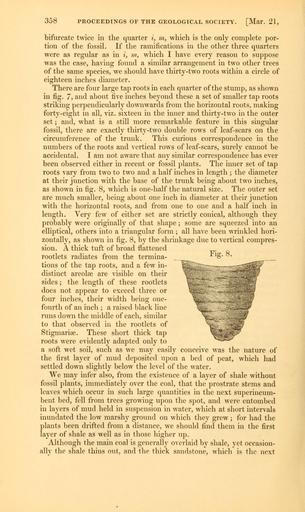MAKE A MEME
View Large Image

| View Original: | The_Quarterly_journal_of_the_Geological_Society_of_London_(12645336583).jpg (1192x1999) | |||
| Download: | Original | Medium | Small | Thumb |
| Courtesy of: | commons.wikimedia.org | More Like This | ||
| Keywords: The Quarterly journal of the Geological Society of London (12645336583).jpg 358 PROCEEDINGS OF THE GEOLOGICAL SOCIETY Mar 21 <br> bifurcate twice in the quarter i m which is the only complete por- <br> tion of the fossil If the ramifications in the other three quarters <br> were as regular as in i 9n which I have every reason to suppose <br> was the case having found a similar arrangement in two other trees <br> of the same species we should have thirty-two roots within a circle of <br> eighteen inches diameter <br> There are four large tap roots in each quarter of the stump as shown <br> in fig 7 and about five inches beyond these a set of smaller tap roots <br> striking perpendicularly downwards from the horizontal roots making <br> forty-eight in all viz sixteen in the inner and thirty- two in the outer <br> set ; and what is a still more remarkable feature in this singular <br> fossil there are exactly thirty-two double rows of leaf-scars on the <br> circumference of the trunk This curious correspondence in the <br> numbers of the roots and vertical rows of leaf-scars surely cannot be <br> accidental I am not aware that any similar correspondence has ever <br> been observed either in recent or fossil plants The inner set of tap <br> roots vary from two to two and a half inches in length ; the diameter <br> at their junction with the base of the trunk being about two inches <br> as shown in fig 8 which is one-half the natural size The outer set <br> are much smaller being about one inch in diameter at their junction <br> with the horizontal roots and from one to one and a half inch in <br> length Very few of either set are strictly conical although they <br> probably were originally of that shape ; some are squeezed into an <br> elliptical others into a triangular form ; all have been wrinkled hori- <br> zontally as shown in fig 8 by the shrinkage due to vertical compres- <br> sion A thick tuft of broad flattened <br> rootlets radiates from the termina- -' ig ° <br> tions of the tap roots and a few in- <br> distinct areolae are \ sible on their <br> sides ; the length of these rootlets <br> does not appear to exceed three or <br> four inches their width being one- <br> fourth of an inch ; a raised black line <br> runs down the middle of each similar <br> to that observed in the rootlets of <br> Stigmariae These short thick tap <br> roots were evidently adapted only to <br> a soft wet soil such as we may easily conceive was the nature of <br> the first layer of mud deposited upon a bed of peat which had <br> settled down slightly below the level of the water <br> We may infer also from the existence of a layer of shale without <br> fossil plants immediately over the coal that the prostrate stems and <br> leaves which occur in such large quantities in the next superincum- <br> bent bed fell from trees growing upon the spot and were entombed <br> in layers of mud held in suspension in water which at short intervals <br> inundated the low marshy ground on which they grew ; for had the <br> plants been drifted from a distance we should find them in the first <br> layer of shale as well as in those higher up <br> Although the main coal is generally overlaid by shale yet occasion- <br> ally the shale thins out and the thick sandstone which is the next 35269008 109512 51125 Page 358 Text v 5 http //www biodiversitylibrary org/page/35269008 1849 Geological Society of London Biodiversity Heritage Library The Quarterly journal of the Geological Society of London v 5 1849 Geology Periodicals Smithsonian Libraries bhl page 35269008 dc identifier http //biodiversitylibrary org/page/35269008 smithsonian libraries Information field Flickr posted date ISOdate 2014-02-20 Check categories 2015 August 26 CC-BY-2 0 BioDivLibrary https //flickr com/photos/61021753 N02/12645336583 2015-08-27 10 59 39 cc-by-2 0 PD-old-70-1923 The Quarterly journal of the Geological Society of London 1849 Photos uploaded from Flickr by Fæ using a script | ||||